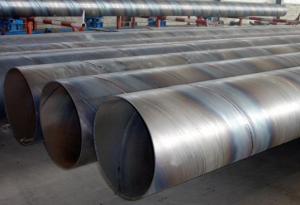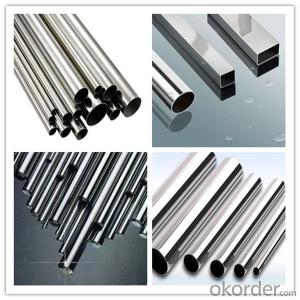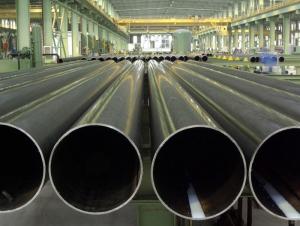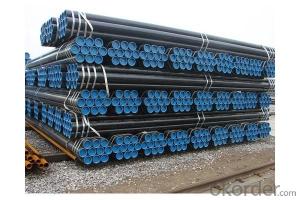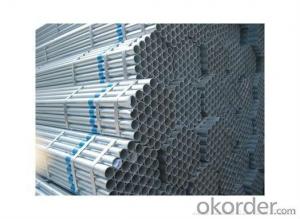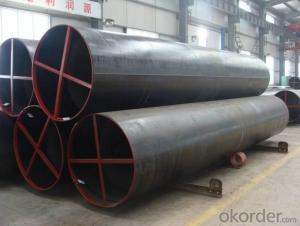High Quanlity Stainless Steel Welded Pipe
- Loading Port:
- Tianjin
- Payment Terms:
- TT or LC
- Min Order Qty:
- 25 m.t.
- Supply Capability:
- 10000 m.t./month
OKorder Service Pledge
OKorder Financial Service
You Might Also Like
1、Structure of Welded Steel Tube:
We are company that have many years experience and professional manager team and engineer team and sales team, sure we will provide you high quality of pipe and professioanl service.Welded Steel Tube is formed by drawing a solid billet over a piercing rod to create the hollow shell. We are company that have many years experience and professional manager team and engineer team and sales team, sure we will provide you high quality of welded pipe and professioanl service.
2、Main Features of the Welded Steel Tube:
• High manufacturing accuracy
• The higher strength
• The small inertia resistance
• Strong heat dissipation ability
• Good visual effect
• Satisfy price
3、Welded Steel Tube Specification:
Standard | GB, DIN, ASTM ASTM A106-2006, ASTM A53-2007 |
Grade | 10#-45#, 16Mn 10#, 20#, 45#, 16Mn |
Thickness | 8 - 33 mm |
Section Shape | Round |
Outer Diameter | 133 - 219 mm |
Place of Origin | Shandong, China (Mainland) |
Secondary Or Not | Non-secondary |
Application | Hydraulic Pipe |
Technique | Cold Drawn |
Certification | API |
Surface Treatment | factory state or painted black |
Special Pipe | API Pipe |
Alloy Or Not | Non-alloy |
Length | 5-12M |
Outer Diameter | 21.3-610mm |
Grade | 20#, 45#, Q345, API J55, API K55, API L80, API N80, API P110, A53B |
Standard | ASME, ASTM |
1) Material:20#(ASTM A 106/A53 GRB.API5LGRB,GB),45#,16Mn,10#.
2) Specification range:OD:21.3-610mm,WT:6-70mm,length:6-12m or according to the requirement of clients.
3) Excutive standards:GB,ASME API5L.ASTM A 106/A53,Despite of the above standards,we can also supply seamless steel pipe with standard of DIN,JIS,and so on,and also develop new products according to the requirements of our clients!
4) Surface:black lacquered,varnish coating or galvanized.
5) Ends:Beveled or square cut,plastic capped,painted.
6) Packing:bundles wrapped with strong steel strip,seaworthy packing.
4、Packaging & Delivery
Packaging Details: | seaworthy package,bundles wrapped with strong steel strip |
Delivery Detail: | 15-30days after received 30%TT |
5、FAQ of Welded Steel Tube:
①How is the quality of your products?
Our products are strictly in accordance with international and domestic standard. We test on every pipe before delivery. Any quality certification or testing report you want to see, please tell us.
Guaranteed: If products’ quality is not in accordance with description as we provide or the promise before you place order, we promise 100% refund.
②How about the price?
Yes, we are factory and be capable of offering you the lowest price. One of our policy is that “ to save time and be absolutely honest with our business relationship, we quote as low as possible for every client, and discount can be given according to the quantity”, if you are interested in bargain and dissatisfy our factory price, just don’t waste your time. Our quotation is professional.
③Why should you choose us?
Choice happens because of our quality and price. Additionally, we can also offer professional products inquiry, products knowledge train (for agents), fast goods delivery, outstanding customer solution proposals. Our service formula: good quality + good price + good service=customer’s trust.
SGS test is available. Customer inspection before shipping is welcome. Third party inspection is OK.
6、 Welded Steel Tube Images:
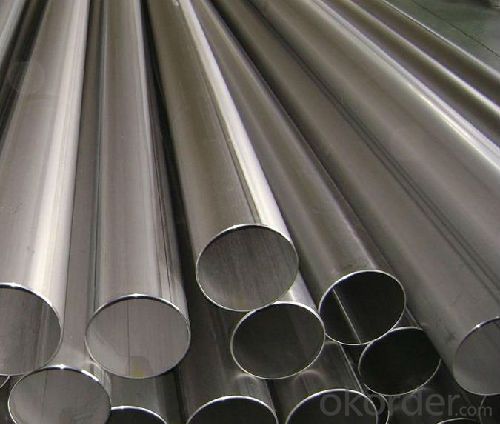
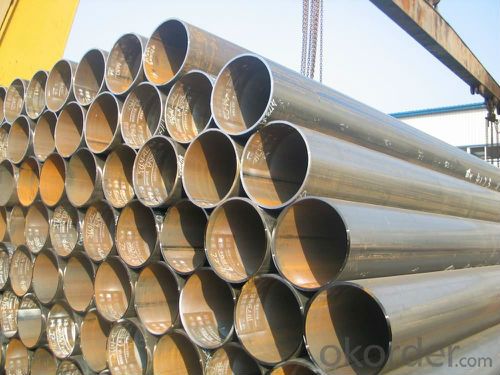
- Q: How do you calculate the pipe length required for a specific application?
- To calculate the pipe length required for a specific application, you need to consider factors such as the flow rate, pressure drop, pipe material, and the type of fluid being transported. By using equations and formulas specific to fluid dynamics, you can determine the appropriate pipe length needed to achieve the desired flow and pressure conditions. Additionally, factors like pipe fittings, bends, and elbows also need to be taken into account when calculating the overall pipe length required.
- Q: Are stainless steel pipes suitable for fire protection systems?
- Yes, stainless steel pipes are suitable for fire protection systems. Stainless steel is known for its excellent corrosion resistance, which is crucial for fire protection systems as they are often exposed to water or other corrosive elements. Stainless steel pipes can withstand high temperatures and maintain their structural integrity, making them reliable for transporting water or other fire suppressants. Additionally, stainless steel pipes are durable and have a long lifespan, reducing the need for frequent replacements or repairs. Overall, stainless steel pipes are a popular choice for fire protection systems due to their reliability, corrosion resistance, and durability.
- Q: Are stainless steel pipes suitable for automotive applications?
- Yes, stainless steel pipes are highly suitable for automotive applications. They are known for their excellent corrosion resistance, high strength, and durability, making them ideal for withstanding the harsh conditions of automotive environments. Additionally, stainless steel pipes offer good heat resistance, which is crucial in automotive exhaust systems. They are widely used in various automotive components such as exhaust systems, fuel lines, brake lines, and cooling systems.
- Q: What are the specifications of stainless steel decorative pipes?
- For the steel to withstand the pressure to the hydraulic test to test its ability and quality, leakage, soaked or expansion for qualified does not occur at the prescribed pressure, some steel according to the requirement of standard or edge test, flaring test and flattening test.
- Q: Can stainless steel pipes be used for nuclear waste storage?
- Indeed, nuclear waste storage can make use of stainless steel pipes. Due to its exceptional resistance to corrosion, stainless steel proves to be an optimal material for the containment and transportation of dangerous substances like nuclear waste. The durability, strength, and capability to endure extreme temperatures of stainless steel render it apt for the prolonged storage of radioactive waste. Furthermore, stainless steel remains non-reactive and prevents the release of harmful substances, thus assuring the preservation of the stored waste's integrity. Nonetheless, it remains crucial to verify that the stainless steel utilized adheres to the specific requirements and standards established for nuclear waste storage to guarantee utmost safety and confinement.
- Q: What is the typical wall thickness of stainless steel pipes?
- The typical wall thickness of stainless steel pipes can vary depending on the specific application and industry requirements. However, it is common to find stainless steel pipes with wall thickness ranging from 0.065 inches (1.65 mm) to 0.250 inches (6.35 mm).
- Q: Can stainless steel pipes be used for power plants?
- Yes, stainless steel pipes can be used for power plants. Stainless steel offers excellent corrosion resistance and high-temperature strength, making it suitable for various applications in power plants, including carrying fluids and gases, heat exchangers, and steam distribution systems.
- Q: Comparison of ring type connection and argon arc welding of stainless steel pipe
- 1. The pipe is embedded in the pipe, and the ring pressure connection strength is high;2. After the ring is pressed, the inserted part of the pipe and the pipe is a closed ring, which can not generate spiral loosening and strong vibration resistance;3. The sealing material fills the entire seal cavity tightly and the seal is very reliable;4. Easy to install and quick.5. Shrinkage and anti drawing test of ring seal joint
- Q: What is the difference between 201 and 316 stainless steel pipes?
- The main difference between 201 and 316 stainless steel pipes lies in their chemical composition and respective properties. 201 stainless steel is a lower grade of stainless steel compared to 316. It contains a higher amount of manganese and nitrogen, which gives it improved strength and corrosion resistance compared to other lower grade stainless steels. However, it is not as durable as 316 stainless steel and is more prone to corrosion and rusting. On the other hand, 316 stainless steel is a high-quality grade that contains a higher percentage of chromium and nickel. These elements enhance its corrosion resistance, making it highly resistant to pitting and crevice corrosion, especially in chloride environments. 316 stainless steel pipes are also more resistant to high temperatures and have superior strength compared to 201 stainless steel pipes. Therefore, 316 stainless steel pipes are widely used in industries with demanding requirements such as marine, chemical, and medical sectors, where corrosion resistance and durability are crucial. 201 stainless steel pipes, while suitable for general applications, are more commonly used in less demanding environments where cost-effectiveness is a priority.
- Q: What kind of welding machine is used for welding thin stainless steel plate and stainless steel square tube?
- But I've already attached a ban on reverse welding (the reverse side is a square tube frame)3. I want it to look good after welding.I was just 4. when reading practice a week of welding, can actually be said to have no understanding of welding after graduation, occasionally with ordinary welding iron will often appear in the weld the warning signs, the other is capable person, not a child, he should be responsible for his behavior. Irrigation can not go fishing? We must also be jointly and severally liable for an accident
Send your message to us
High Quanlity Stainless Steel Welded Pipe
- Loading Port:
- Tianjin
- Payment Terms:
- TT or LC
- Min Order Qty:
- 25 m.t.
- Supply Capability:
- 10000 m.t./month
OKorder Service Pledge
OKorder Financial Service
Similar products
Hot products
Hot Searches
Related keywords
